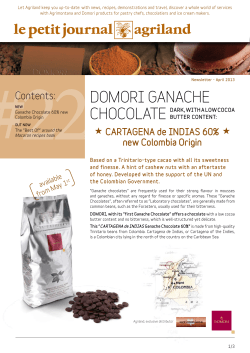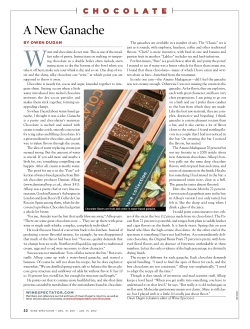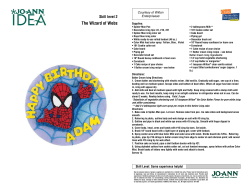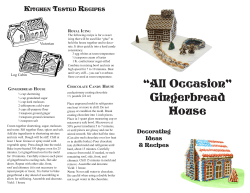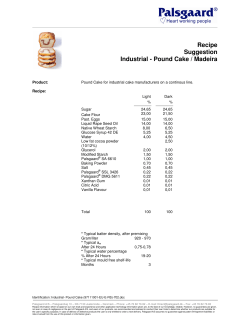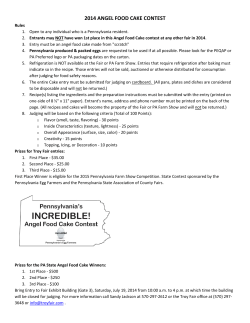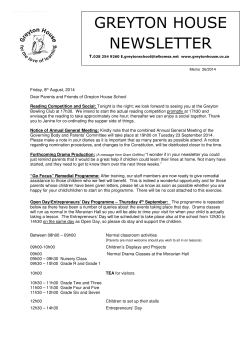
INSPIRATION HOW-TOs Chocolate Ganache Filling and Glaze
INSPIRATION HOW-TOs • chocolatecraftkits.com Chocolate Ganache Filling and Glaze Ingredients for Ganache: Materials: 1 ¾ cups heavy or whipping cream Cake board or plate optimally the same size as the cake. 3 oz corn syrup Icing rack or tuna type can to hold cake while glazing 1 # dark chocolate, in small even pieces or ready to use discs Icing spatula 1 ½ oz soft butter Bowl and hand whip, or mixer and paddle attachment 1. Combine the cream and corn syrup in a saucepan. 2. Put the chocolate in a microwaveable bowl. 3. Bring the cream and corn syrup to a boil, and then pour it right away over the chocolate pieces. Put the pat of butter on top. Let it sit a few minutes to cool. When the chocolate is melted and the mix is just slightly warm, stir with spoon or spatula beginning in the middle with small, central motion. When the middle of the bowl by the spoon gets dark expand the stirring circle until you are gently stirring the entire bowl and the ganache is thoroughly melted and homogeneous. The ganache is now emulsified (the fat and liquid are temporarily blended). Stop stirring to avoid bubbles. If you have a handheld immersion blender, use that instead of a spoon. It is excellent for emulsifications. Take care to keep the blade immersed or chocolate will be everywhere! Working with Ganache The same recipe for ganache can be finished and used for different purposes. For filling and icing, incorporate a small amount of air to make it both lighter and firmer. When used as a glaze it should flow freely, so excess stirring and incorporating air is undesirable. The key to using ganache is getting the right temperature and consistency for the application. Ganache Whipped Filling and Icing: Cool temperature, light whipped Ganache Glaze: Body temperature to slightly warm. No whipping or bubbles This recipe for ganache can be used as a glaze or as a filling, but it is too soft to use for truffles dipped in chocolate. Ganache can be re-warmed, cooled, and whipped as many times as needed. Cakes are thinly iced with lightly whipped ganache before covering with glaze. This creates a barrier to keep the ganache from soaking into the cake, leaving an uneven, pitted surface. Use about a cup of the ganache for either filling or thinly icing a 9” cake. To make whipped filling or icing, cool the ganache at room temperature several hours, or stir gently over ice water for a minute or two until it has the consistency of heavy pudding. The ganache must be par tially set in order to trap bubbles that will make it both fluffy and firm. As ganache is aerated it becomes lighter brown. When over-whipped, ganache is a bit grainy and sets up almost INSPIRATION HOW-TOs • chocolatecraftkits.com immediately. When your cake is ready for filling or icing and the ganache is thick, whip it by hand or in a mixer with a paddle for just a minute. As soon as it turns a shade lighter, stop mixing and use immediately before it begins to set. If the ganache is hard to spread, dip the icing spatula in warm water. If the ganache gets too stiff to spread, warm it in the microwave a few seconds at a time on medium power. If it overheats and liquefies, begin again by cooling the melted ganache and lightly rewhipping until just thick enough to hold its shape. For glazing (a shiny poured coating) the ganache should not be aerated or whipped, but be evenly runny and slightly warm to the touch. If necessary, warm the glaze in the microwave at half power a few seconds at a time, stirring slightly to even out the temperature without adding air. When the glaze is warm to the touch, test its consistency by dipping your finger or a measuring spoon into the glaze. There should be a thin coating. If the ganache is too thick, warm it a little more, but do not get it hot. When ready to glaze, the cake should be iced and cool and on a cardboard or plate no wider than the cake itself. Then place it on an icing rack or flat can to allow excess glaze to run off the edges. A pan underneath will catch excess glaze to save and re-use. Have an icing spatula at hand for smoothing the glaze. Pour the prepared ganache around the top of the cake, letting it run down the sides. If necessary, pour some glaze onto the center of the cake. You may use an icing spatula to coax it over the sides and smooth it, but the less the glaze is worked, the shinier it will remain. Allow the glaze to set before decorating. If the glaze does not reach the bottom evenly, use your imagination. Modeling Chocolate leaves or whipped ganache piping are two of many good choices for making a bottom border or decorations to cover imperfections.
© Copyright 2025
